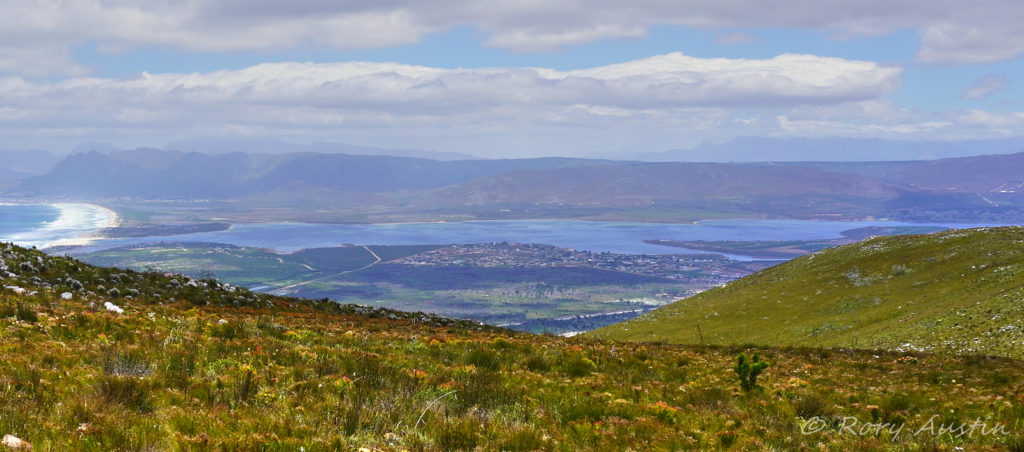Clearing exotics within suburban areas is a brief initial document superseded by a more comprehensive document on dealing with invasive species in the whole Fisherhaven Hawston area. This was also followed by a more comprehensive document on fire as a natural occurrence in this area. This is also background to the status of biological invasions in the Bot estuary and environs following on the national biodiversity and biological invasions bill and comments by Botfriends.
Michael Austin M Sc Agric
The clearing of exotic invasive species within suburban areas, on both private and public land, needs to be done for a number of reasons:
The laws governing the removal of invasive exotics are very specific about how they should be removed and are backed up by years of scientific research. Simply chopping down most of these is a waste of time and money.

Port Jackson, Myrtle and Eucalyptus
These re-grow very quickly from the base of the plant, especially with the huge root system still in place and outcompete anything else trying to grow there.
The basal buds need to be removed either by pulling out, chopping below ground level or by poisoning the stump.
Pines
The growing point is at the top of the plant – simply cut off above ground.
Much of the clearing of exotics within Fisherhaven has been ineffective. Using a weed eater or other methods of cutting or slashing is ineffective and costly in the long run. People are paying anything from R1 500 to R10 000 to have a plot cleared. If it is not done correctly, the Port Jackson can be 1.5m high again within a year, and will need to be cleared again and be just as dense, if not more so. This clearing then becomes a recurring expense. If the clearing of exotics is done properly the first time around; a year later, there will be a few plants, maybe a half metre high. These can be easily and inexpensively removed by the gardener for, say, R400. This cost will reduce even more with time, depending on seed from adjacent plots.
We have to eradicate the seed sources and do timely follow-ups; just one invaded plot supplies enough seed to affect dozens of surrounding plots. As a community we are losing the battle against invasive species and need to take collective action or we will allow our once-beautiful environment to deteriorate to the point where it becomes too expensive to save. We have the means and knowledge to save it, all we need is the will to do it now with properly-planned, effective and timely intervention.
Plot owners need to be educated as to the reasons for clearing exotics and how to do it correctly. Pressure can then be applied to the plot owners who have not complied. This is much easier once most of the area has been cleared.
The clearing of exotics on publically-owned land within Fisherhaven will probably have to be done by volunteers as the OSM has failed to get this done in the past.
A workshop can be organised by e.g. Fisherhaven Ratepayers, BotFriends or Overbot Conservancy, I would be happy to assist free of charge with training in the recognition and the removal of invasive species.
Fire and exotics re-growth
Huge increases in seed of exotic species in the soil result in rapid growth of seedlings in bare patches, especially after fire. The apparent greening of the veld is most often because there are exotic plants growing.
For example; the fire above the R43, just outside of Hawston, where there were Port Jacksons growing, maybe one plant per 10 metre square. The seedlings emerging now are in the region of 10 plants per metre square, a hundred times as many as there were before the fire. Luckily only 1 or 2 of these will grow well because they out-compete each other, therefore only twenty times as many as before the fire. But there are still enough plants that they will canopy over and completely shade out any other plants and look like the area below the R43, and the area south of China Marais Avenue. With no fynbos to even produce seeds, the area rapidly deteriorates and presents an extreme fire hazard. A similar situation has occurred on the land across Stormalong Road in Fisherhaven, where the fire load has now increased to more than twenty times what it would have been with Fynbos, both because there is much more volume of material and because the Port Jackson is much more volatile because of the high flammable oil content of the leaves. When this does burn, which is inevitable in the near future, it is an extreme hazard to the infrastructure in Fisherhaven, and it increases every year. When it burns it will probably be very dry with high winds – ideal conditions for a runaway fire. The fire brigade cannot stop it spotting fire way ahead of the main fire and the fire break of Stormalong Road becomes of little use, except to put in a backfire.

Recent Comments